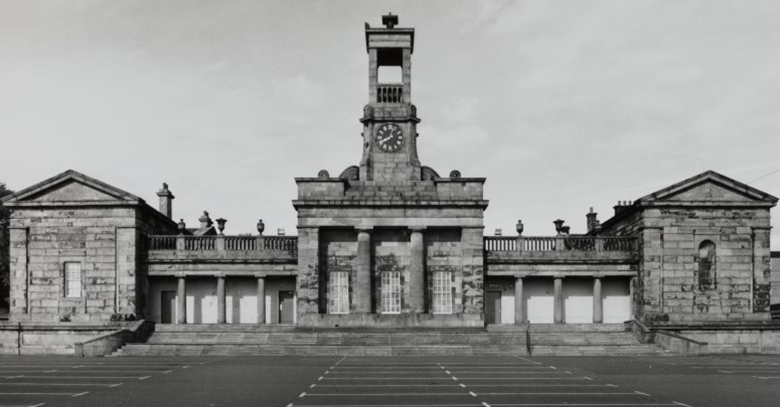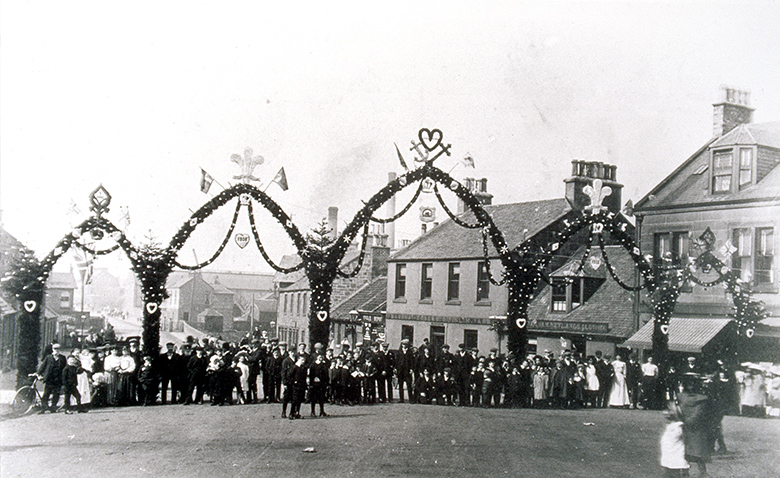For many generations Gala Days have been held in towns throughout West Lothian, including Armadale, Whitburn and Fauldhouse. However, as a Bathgate resident, I wanted to dig into the longstanding tradition of my adopted home.
When I arrived as an immigrant 18 years ago, the procession and Gala Day just seemed like the Fourth of July parades, or other local celebrations I had previously attended in the USA.
In Bathgate, the community comes together for a procession. There’s music, food, shows and activities in Meadow Park afterwards. Many people decorate their houses with bunting displays. Yet I have come to appreciate that there is much more to it than that.
Historical beginnings
The inaugural Procession (or parade) was held in 1844 to honour John Newlands. Newlands was a wealthy gentleman with connections to the sugar and slave trade in Jamaica. His bequest provided funds for the construction of the old Bathgate Academy that opened in 1833.

Old Bathgate Academy. Take a closer look on Canmore. (© Crown Copyright: HES)
The Academy was initially the starting place for the procession, which in later years would be extended past the previous West Lothian Council building along Glasgow Road.

Lindsay House, Bathgate. (Photograph by Richard Jaques. Courtesy of HES)
Growing interest
Bathgate itself, and participation in the Procession has grown over the years. New roles were added to celebrate more aspects of Bathgate’s history. This photograph from 1924 shows students from Bathgate Academy dressed as Princess Marjorie, daughter of King Robert the Bruce, and her husband Walter Lord High Steward of Scotland, who was granted Bathgate Castle upon their marriage.

In 1924 Grace Telfer and Quentin Bisset, two senior pupils of Bathgate Academy, were chosen to take the parts of Walter the High Steward, and Princess Marjory. (© St John’s Church, Bathgate. Licensor www.scran.ac.uk)
Bathgate Castle appears on the coat of arms for the town. The only visible remains of it can be found in aerial photography of the local golf course.

From the air, you can see the site of Bathgate Castle. Two ditches surrounding the mound mark where the fortress once stood. Explore more on Canmore. (© Crown Copyright: HES)
Memories
Many local school children have fond memories of the Gala Day. Walking with their classmates, serving as flower girls, pages, heralds and ladies-in-waiting, or riding atop one of the decorated floats in the procession are all ways that the local children can get involved.

St. Mary’s Primary School march during Bathgate Gala Day in 1961 (© The Scotsman Publications Ltd, licensed via Scran)

The Windyknowe Primary School parade float at a parade in the 1960s (© The Scotsman Publications Ltd, licensed via Scran)

Principal characters in the 1962 parade (© The Scotsman Publications Ltd, licensed via Scran)
Community pride
The Gala Day and the procession has always provided the people of Bathgate with the opportunity to show off their very best outfits, creativity in decorating their homes, and ways in which they can represent their school, business, club, or community pride!

Bathgate Gala Day 1954 (© The Scotsman Publications Ltd, licensed via Scran)

The fairies, Bathgate Gala Day 1961. (© The Scotsman Publications Ltd, licensed via Scran)

Children in fancy dress, 1960. (© The Scotsman Publications Ltd, licensed via Scran)

A band at Bathgate Gala Day 1961 (© The Scotsman Publications Ltd, licensed via Scran)

Bathgate Public Band, 1960 (© The Scotsman Publications Ltd, licensed via Scran)
Associated activities
When I think of the Gala Day, there are many other traditional and fun things that come to mind. There has almost always been a set of arches constructed in the town centre. We have a spectacular early photo of a massive five-arch display in our archive.

Newland’s Day Arch, 1908 (© West Lothian Council Libraries, licensed via Scran)
No Gala Day can be held without a wake-up call from the drummers! Beginning at 6am they walk the streets playing a simple beat that signals the big day has finally arrived, and it’s time to start getting ready.

The walk around town for the drummers of Bathgate Public Band 1961. (© The Scotsman Publications Ltd, licensed via Scran)
The house decorating competition is fierce every year. Nowadays there are multiple judging categories and lots of Disney-oriented themes, but the traditional way is to create a spruce arch and use crepe paper flowers.

Princess Marjorie leaves home for the pageant in 1965 (© The Scotsman Publications Ltd, licensed via Scran)
Local officials or persons of some notoriety deliver an oration. Essentially this is someone giving a speech, and it’s often combined with handing out awards to volunteers and other heroes of the community.

Bathgate Gala Day 1961 (© The Scotsman Publications Ltd, licensed via Scran)
Where there are music and people, there must be a dance! In years gone by the place to be seen was the Co-op Hall. Now it’s the ‘Gala Day park’ where there are multiple stages, food booths, entertainment displays, and fireworks at the end of the night:

Gala Day Dance in the Co-op Hall, 1960 (© The Scotsman Publications Ltd, licensed via Scran)
My impressions
As I stood in the sunshine on the Glasgow Road for the 2024 Gala Day, I listened in to conversations around me. I realised I was in ‘our spot.’ For many years now I have been meeting up with the same friends, in the very same location, to watch the procession together. It is an inherited spot, as it started with my friend’s dad, whose house was just a few doors down. And the beauty of it is that everyone else also has memories of their own spot!
You can see parents proudly taking photos of their kids as they go past in the procession, and neighbours cheerfully chat to one another as they rush back home to get their BBQs started. In a town that has grown significantly in recent times, it is a good feeling to know that these community events are working hard to be inclusive, and are still bringing people together in so many positive ways.

Bathgate Gala Day 2024 (Author’s photo)
The amazing archive photos used in this blog are from Scran and Canmore. SCRAN is our online learning service. It contains over 400,000 images and media from museums, galleries and archives from across Scotland and beyond.
Canmore is the online catalogue for the National Record of the Historic Environment. Here you can find images and records relating to the architecture, archaeology, industrial and maritime heritage of Scotland.
About the author
Mindy Lynch works as an Archivist in the HES Archive. She regularly answers enquiries and assists members of the public with navigating the millions of records we hold relating to Scotland’s historic environment.

